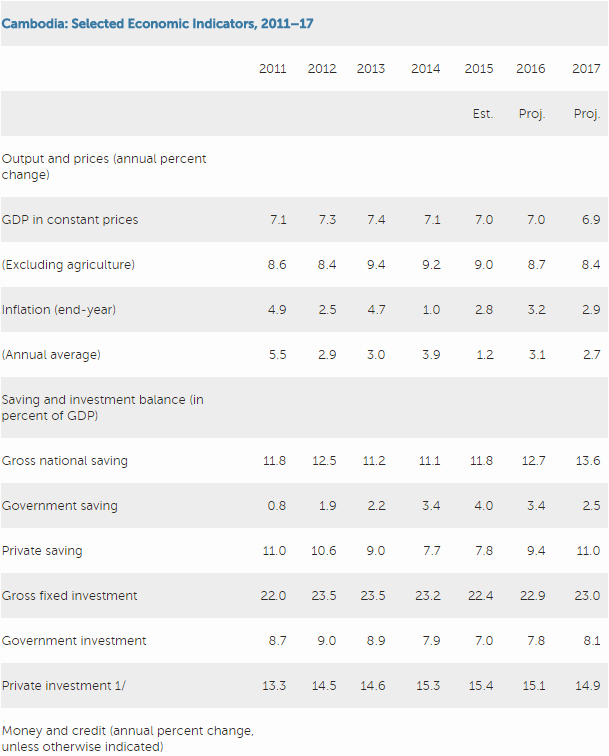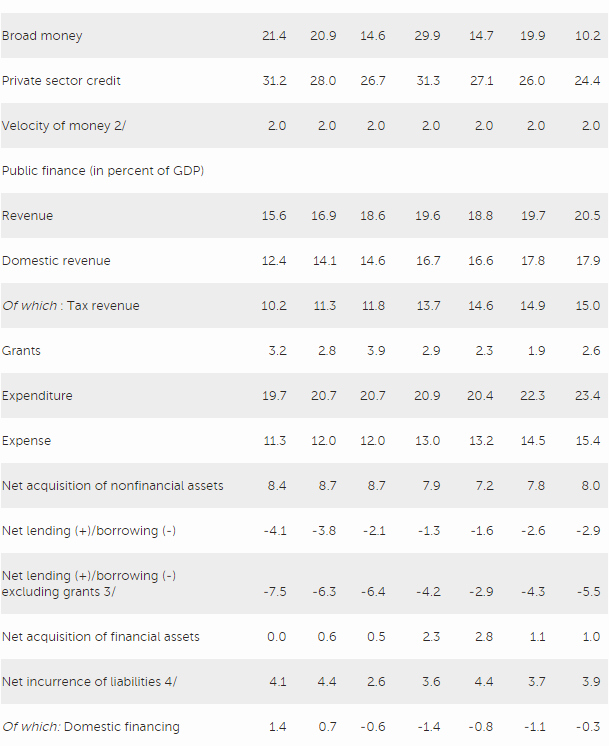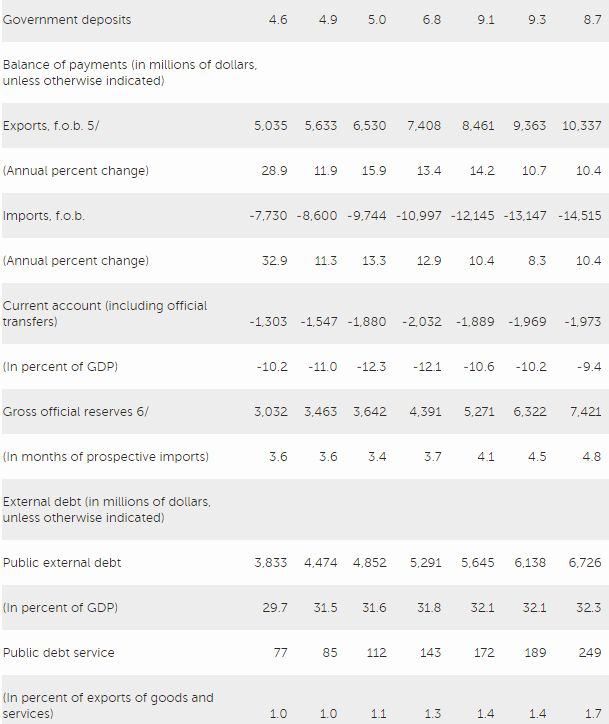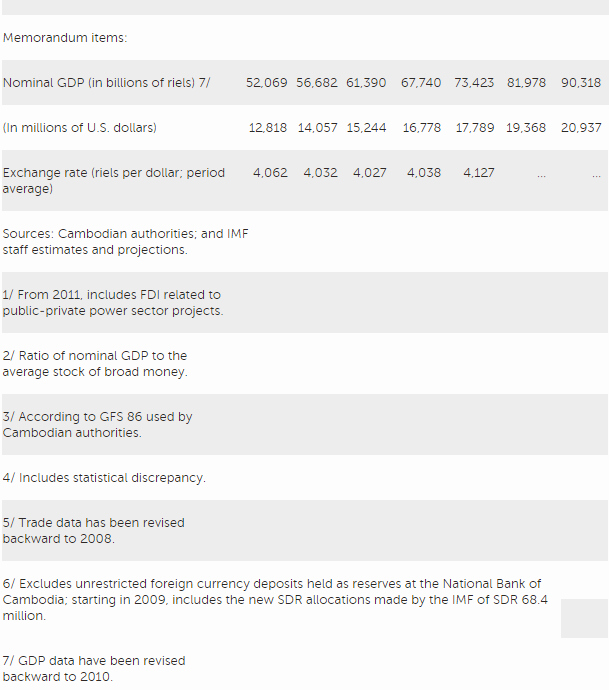IMF Executive Board Concludes Article IV Consultation with Cambodia
On October 19, the Executive Board of the International Monetary Fund (IMF) concluded the 2016 Article IV consultation with Cambodia.
Cambodia is a fast-growing, highly open economy, and attained lower-middle income status this year. The Cambodian economy grew at around 7 percent in 2015, supported by strong garments exports, real estate and construction activity as well as the reduction in oil prices. Inflation unexpectedly picked up at end-2015 to 2.8 percent due to higher food prices resulting from extreme weather, but it remains well contained. Private sector credit growth has averaged nearly 30 percent (year-on-year) over the past three years, doubling the credit-to-GDP ratio to 62 percent by end-2015, which exceeds the median emerging market level and is double the median low-income country level.
The current account deficit (CAD) narrowed to 10.6 percent of GDP in 2015, and is largely financed by FDI and official flows. Gross official reserves rose to US$ 5.3 billion at end-2015, more than 4 months of prospective imports. The fiscal deficit narrowed to 1.6 percent of GDP in 2015, below the budget target, as the result of stronger-than-expected revenue growth, owing to improved revenue administration.
The near-term outlook remains broadly favorable. Growth is projected to remain robust at around 7 percent for 2016–17, supported by strong garments exports, real estate and construction activity, notwithstanding weaker agricultural and tourism growth. Medium-term growth is projected to decline to around 6.3 percent by 2021, due to a moderation in the credit cycle and challenges in economic diversification. The current account deficit (CAD) is projected to narrow to 9.7 percent of GDP in 2016, due to reduced imports following the completion of major hydro projects, low commodity prices and growing remittances. Over the medium-term, the CAD is forecast to decline to around 8.5 percent of GDP.
The outlook is subject to substantial downside risks. Rapid credit growth, along with growing concentration in real estate, poses heightened risks to financial and macroeconomic stability. External risks include a significant slowdown in China, U.S. dollar appreciation, structurally weaker growth in Europe coupled with increased uncertainty from the Brexit referendum result, and a sharper-than-anticipated tightening in global financial conditions.
Executive Board Assessment
Directors welcomed Cambodia’s robust economic growth over the last two decades, which has resulted in an impressive decline in poverty and the country’s successful transition to a lower‑middle income status. Directors noted that while the growth outlook remains strong, the economy faces downside risks stemming from rapid credit growth, fiscal pressures, and possible spillovers from an uncertain external environment. They recommended that policies ahead should focus on securing sustained growth and mitigating financial sector vulnerabilities, including by enhancing resilience and building buffers.
Directors considered the current fiscal stance to be appropriate and commended the improvements in tax administration, which helped increase revenue and accumulate government deposits in the banking system. To sustain these gains, they encouraged modernization of tax policy and further efforts to strengthen revenue administration. Directors also advised that future increases in public wages should be fiscally sustainable and accompanied by continued civil service reform. They recommended curtailing non‑development current spending and saving excess revenues in the event of overperformance. In addition, Directors encouraged the authorities to develop a medium‑term fiscal framework, improve expenditure allocation efficiency, as well as strengthen the monitoring of contingent liabilities, particularly from public‑private partnerships.
Directors welcomed the steps being taken to bolster financial stability, noting the recent institution of the liquidity coverage ratio and minimum capital requirements. They highlighted that stronger efforts will be needed to achieve a soft landing of the credit cycle and safeguard macro‑financial stability. Directors underscored that well‑coordinated policy measures, including raising reserve requirements, putting in place macroprudential measures, and strengthening micro‑prudential regulations will help moderate the pace of credit growth and bolster financial stability. In addition, they encouraged upgrading and tightening of prudential regulations on large deposit‑taking micro‑finance institutions to match those of banks. Developing a crisis management framework will also be important going forward.
Directors welcomed the policies to promote financial market development, particularly improvements in the negotiable certificates of deposits market. They considered that further progress in developing an interbank market is important for laying the groundwork for market‑based monetary policy operations. They also recommended policies to promote de‑dollarization and accelerate broader financial market development.
Directors encouraged the authorities to step up their efforts to boost competitiveness and promote economic diversification. Reducing the cost of doing business will help enhance competitiveness and foster diversification and inclusiveness. Directors highlighted that lowering energy costs, upgrading infrastructure, addressing skills bottlenecks, as well as strengthening transparency will also contribute to fostering inclusive and sustained growth.




Source: International Monetary Fund
- 356 reads
Human Rights
Fostering a More Humane World: The 28th Eurasian Economic Summi

Conscience, Hope, and Action: Keys to Global Peace and Sustainability

Ringing FOWPAL’s Peace Bell for the World:Nobel Peace Prize Laureates’ Visions and Actions

Protecting the World’s Cultural Diversity for a Sustainable Future

Puppet Show I International Friendship Day 2020

